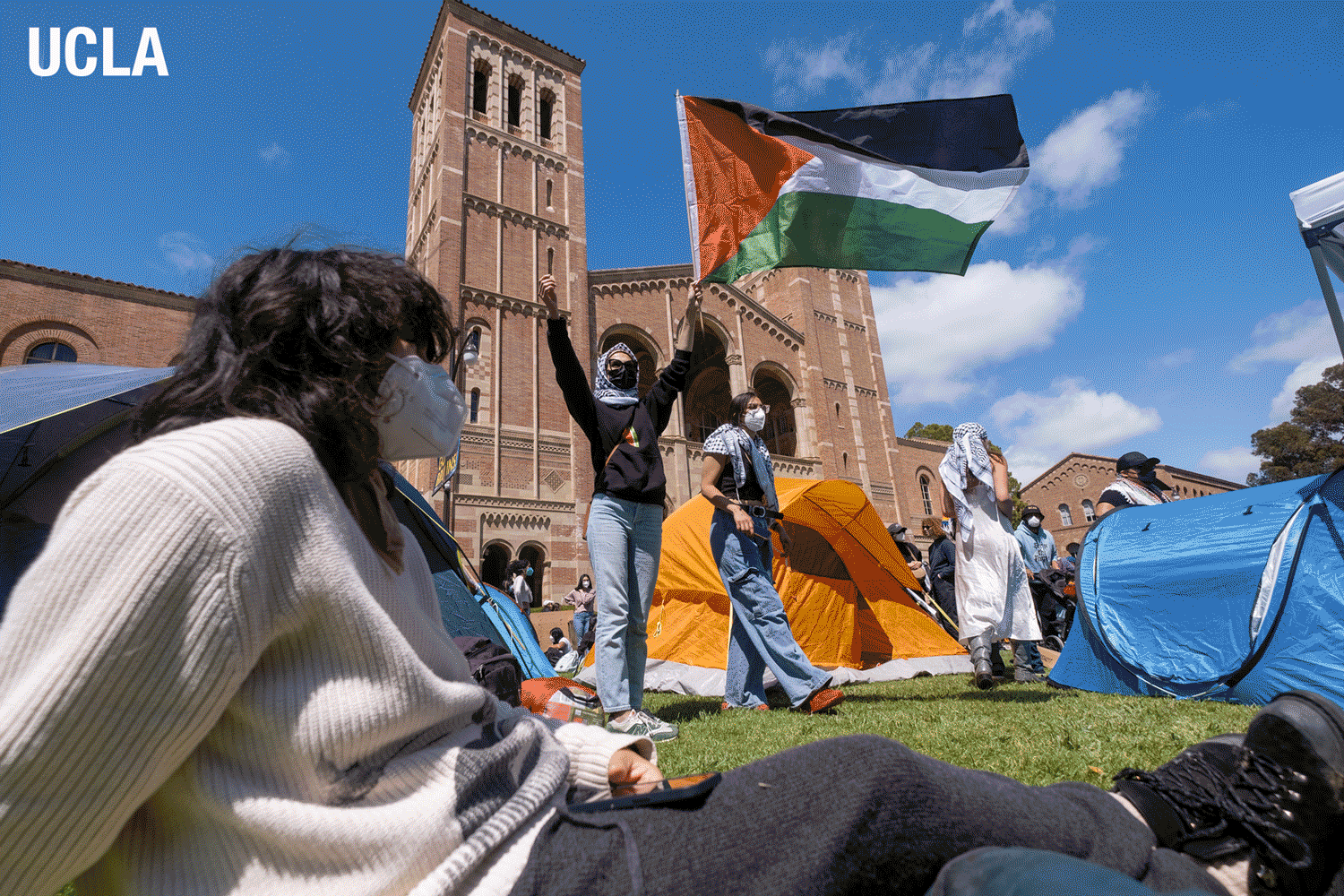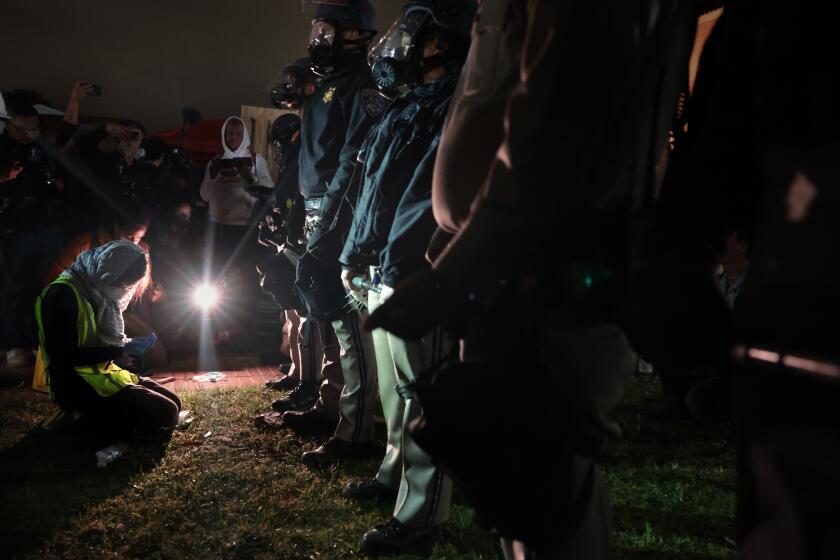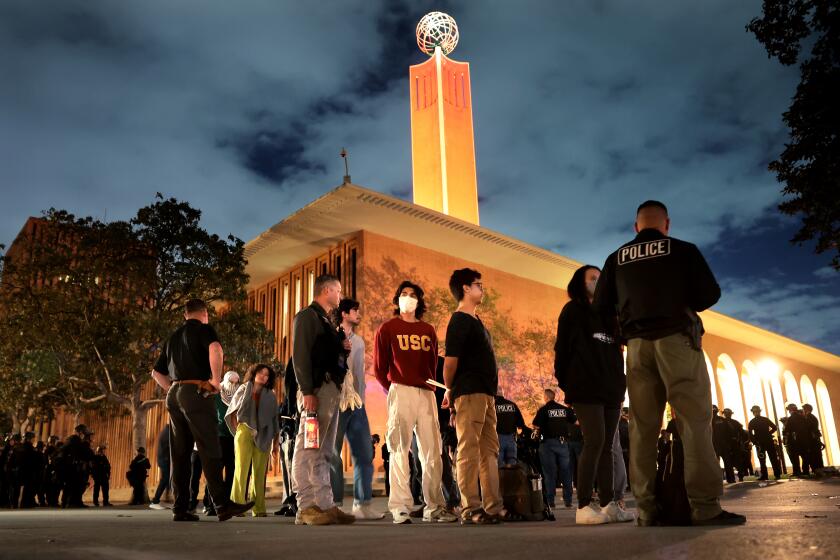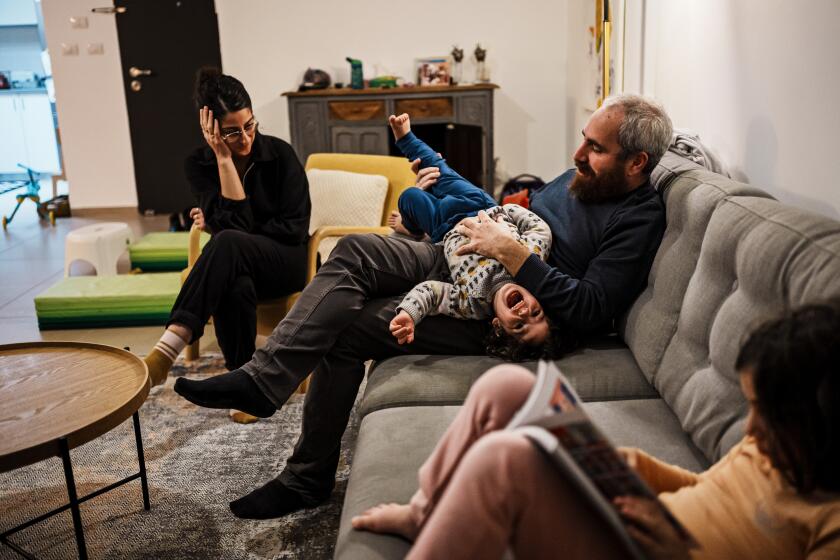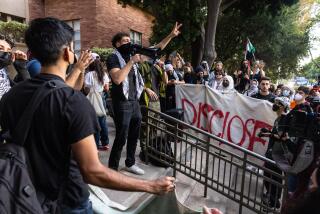Ali: University protests dominate media coverage, obscuring the true horror of Gaza war
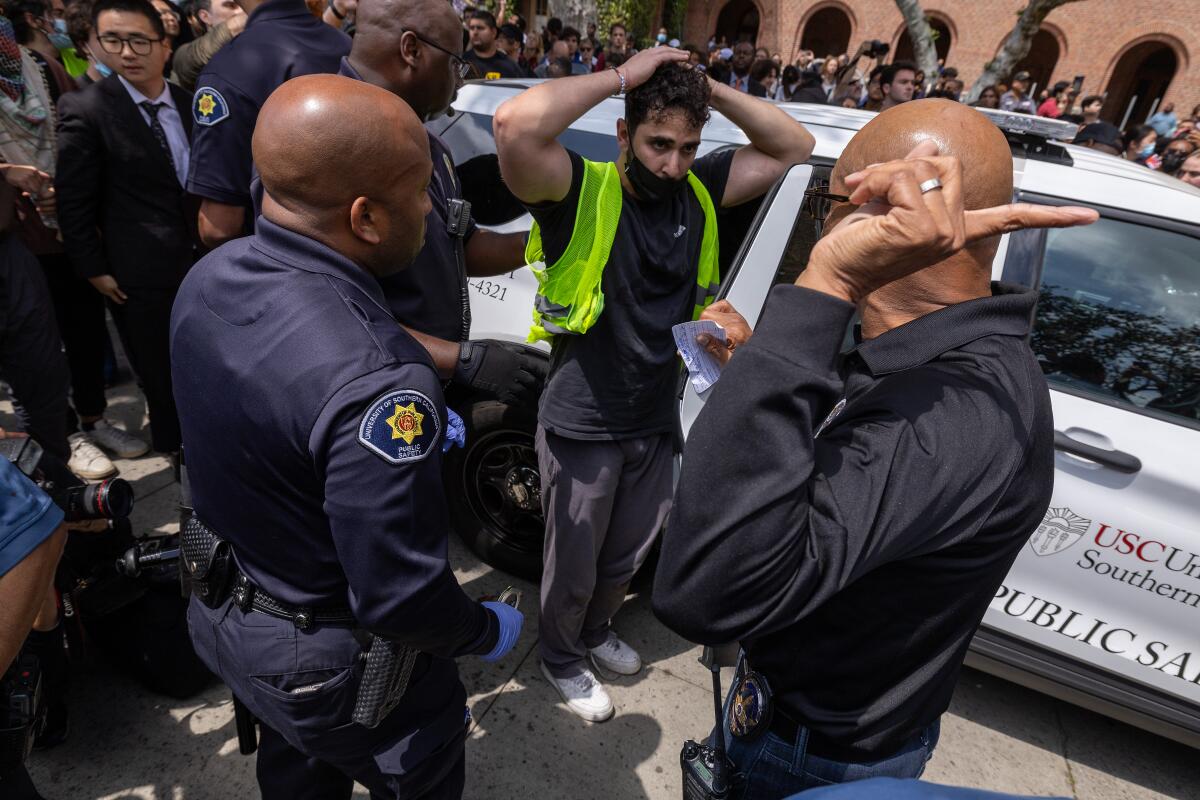
- Share via
The mention of mass graves is so deeply disturbing that it’s preferable to think of such wartime horrors as dark remnants of another era, chapters of history we’ll never repeat. The Armenian genocide, the Bolshevik revolution, Nazi Germany, El Salvador, Bosnia-Herzegovina.
The fairy tale that the human race has evolved beyond such barbarism was shattered (again) last week when reports surfaced that three mass burial sites had been unearthed in Gaza. The shocking development should have made headlines, but it barely made it onto most people’s radars.
The media are instead hyper-focused on how we protest atrocities rather than the atrocities themselves.
At USC, police in riot gear arrested 93 pro-Palestinian protestors, while UCLA sent in observers who kept their hands off students in a peaceful encampment.
Anti-war demonstrations on college campuses dominate conversations and coverage about the Israel-Hamas war. Every imaginable news source — legacy print outlets, user-generated posts, broadcast and cable news — has its sight set on the encampments and rallies breaking out on campuses across the nation.
The protests are worthy in their own right for drawing attention to critical issues. They’ve raised awareness (and hackles) around the staggering Palestinian death toll, antisemitism, occupation, the oft-forgotten hostages and free speech. The largely peaceful demonstrations, dealt with ineptly at best by university heads and law enforcement, are rightfully the leading national story, and its stars are a generation that many older folks had written off as apathetic.
As pro-Palestinian protests grow at California colleges and universities, counterprotesters spark clashes at UCLA.
In SEO terms, the protests present the perfect setting for a media blitz. They’re taking place at colleges and they come with powerful images and ample social media content. As an example, protests at USC unfolded live on television across various local stations, with choppers capturing the action from every imaginable angle. They’re also an easier way into the war, bringing the Mideast conflict home to America without the horror of witnessing a real battle.
How USC’s controversial decision on Asna Tabassum’s valedictorian speech led to nearly two weeks of campus tension with 93 arrests and a canceled ‘main stage’ commencement.
But blanket coverage of the uprising by students is so omnipresent, it’s overshadowed news from the very war they’re protesting.
There’s been a stunning lack of coverage and outrage following an announcement Friday by Palestinian authorities that they’d uncovered 390 bodies from mass grave sites around Gaza’s Nassar and Shifa hospitals, facilities that were raided and destroyed in Israeli strikes. The bodies were reportedly found in the pits, buried by bulldozed debris, after the Israeli Defense Forces ended operations in the region.
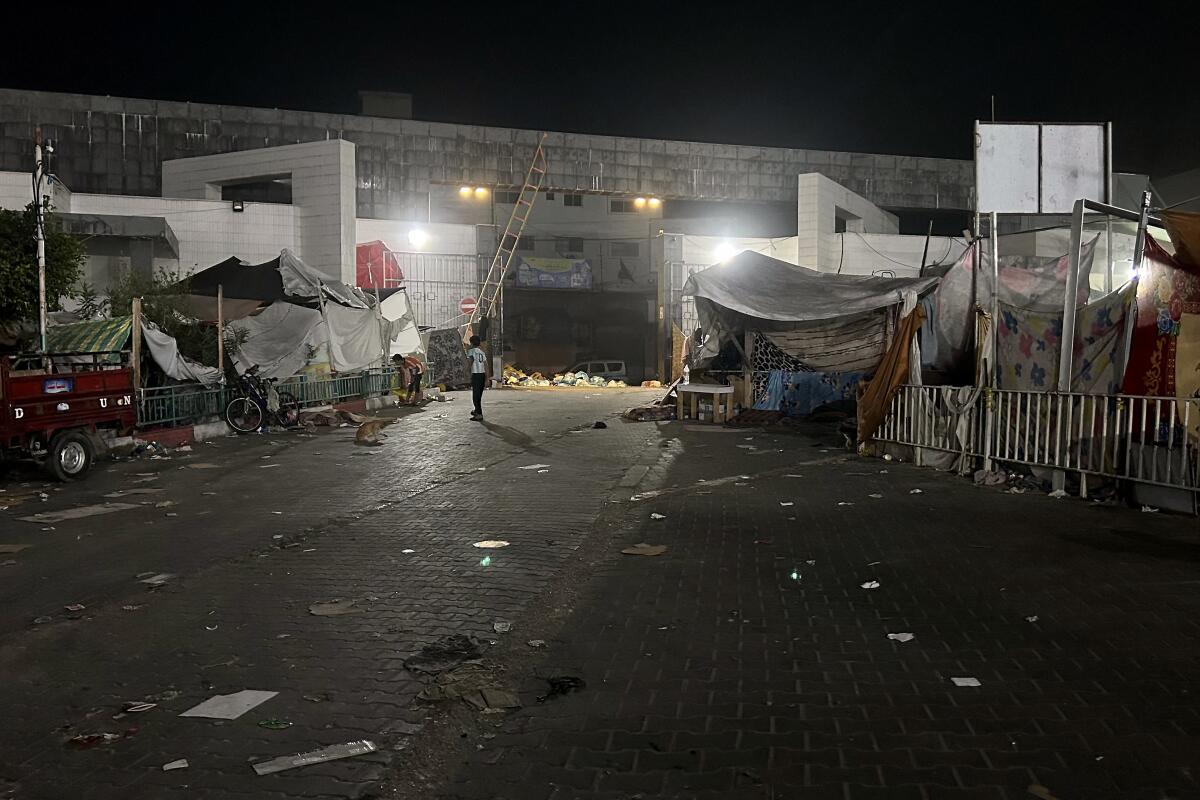
Women and children are among the deceased; the majority are still unidentified. Some of the dead were allegedly found stripped naked with their hands bound behind their backs. “It indicates serious violations of international human rights law and international humanitarian law, and these need to be subjected to further investigations,” said Ravina Shamdasani, a chief spokesperson for the U.N. high commissioner for human rights, Volker Türk.
The sheer barbarity of these scenes may explain why they haven’t garnered more attention. It’s simply too awful to process, so we turn away.
And if the discovery of mass graves is a hard story to watch, it’s an even harder one to cover. Israel continues to restrict international journalists’ access to Gaza, so there are fewer reporters there to bear witness. For those who are there, it’s one of the deadliest wars on record for media workers, and civilian casualties are more than 34,000. If reporters do survive, they’re faced with intense investigative digging to get to the truth. And when their stories are finally reported, they’ll be lambasted, trolled and harassed by one side — or both — for their perceived bias.
But we need answers, and short of an independent investigation (the Biden administration has left it up to Israel to investigate itself), we’re left to guess whether war crimes have or have not been committed.
The dearth of information is partly due to the contraction of American newsrooms. Journalism outlets big and small have lost the resources, access and the expertise to cover wars like they once did. It’s also up to elected officials to draw attention to potential war crimes, especially when the U.S. plays such a central role in the conflict.
Politicians like Mike Johnson have instead been busy raising their profiles by inserting themselves into the Palestinian-Israeli mire. Painting himself as a defender of student safety, the Republican House speaker instead put hundreds if not thousands of anti-war protesters in danger — Jewish students included — by conflating their pro-Palestinian stances with sympathy for Hamas. “The things that have happened at the hands of Hamas are horrific, and yet these protesters are out there waving flags for the very people who committed those crimes. This is not who we are in America,” Johnson posted Thursday on X, formerly Twitter.
At a rare bilingual school in Israel, students coexist and learn in Arabic and Hebrew together. Could parents follow their example?
It was refreshing to see that ABC News didn’t just quote him and move on, as many other news outlets did. The network reported that there had been no documented cases of demonstrators waving Hamas flags. Such details matter when the safety of students is at stake.
But critical questions remain around Gaza’s mass graves, and there’s the matter of accountability.
“The grave in question was dug — by Gazans — a few months ago,” tweeted Nadav Shoshani, a spokesman for the Israeli Defense Force. “This fact is corroborated by social media documentation uploaded by Gazans at the time of the burial. Any attempt to blame Israel for burying civilians in mass graves is categorically false and a mere example of a disinformation campaign aimed at delegitimizing Israel.”
Israeli officials said the corpses buried near Nasser Hospital had been exhumed to check whether they were those of Israeli hostages. An Israeli military official said that all remains were then “respectfully returned to their place.”
Gaza authorities affirm that graves were dug before the Israeli military’s arrival, but allege that the IDF added bodies to the site. Gaza Civil Defense said that only about 100 people were buried in graves before the IDF raid, and that 390 to 392 bodies (accounts vary) had since been recovered.
The widely reported slaughter of innocent Israelis and Palestinians, and the taking of hostages, prompted the protests in the first place. Now, the cries of demonstrators are the story. But we can certainly pay attention on both fronts, even if one of them requires a lot more work and emotional girding. It’s our moral imperative to pay attention or risk becoming bystanders as another dark chapter on wartime atrocities writes itself.
More to Read
The complete guide to home viewing
Get Screen Gab for everything about the TV shows and streaming movies everyone’s talking about.
You may occasionally receive promotional content from the Los Angeles Times.
